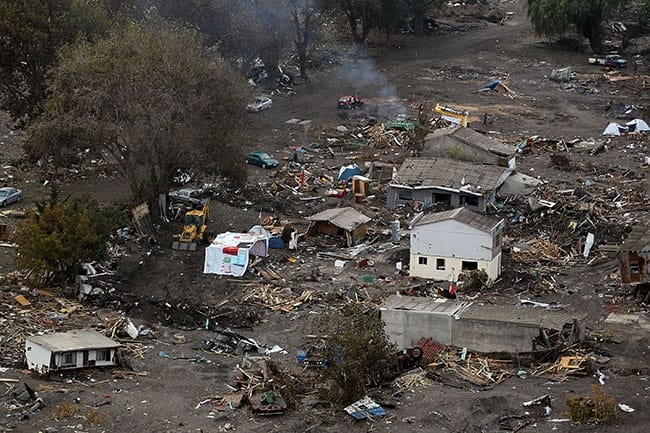Editor’s note: Howard Kunreuther, Wharton’s James G. Dinan Professor of Decision Sciences and Public Policy and Co-Director of the Wharton Risk Center, and Erwann O. Michel-Kerjan, executive director of the Wharton Risk Center, co-authored this article.

Professors Michael Useem. Erwann O. Michel-Kerjan and Howard Kunreuther (left to right). Photo credit: Tommy Leonardi.
Imagine you are the newly elected president of your country, waiting to enter office. Just 10 days before your inauguration, a massive magnitude-8.8 earthquake rocks your country. It is the sixth largest seismic event of the modern era, 500 times more powerful than the quake that had killed more than a quarter-million people in Haiti in 2010. How do you prepare for the recovery process? How do you bring your country back on track rapidly?
Chile’s great earthquake of Feb. 27, 2010, and the resulting tsunami destroyed schools, hospitals, roads and homes, paralyzing the country for weeks. The economic damage was equal to 18 percent of the Chile’s gross domestic product, the equivalent of a $2.7 trillion loss in the United States, 20 times greater than that caused by Hurricane Katrina in 2005, America’s most costly disaster in recent history.
It could take years for some countries to recover from such widespread devastation, but Chile shifted into high gear. It mobilized to help the injured and bury the dead, then turned to repairing hospitals, reopening schools and rebuilding homes. President Sebastián Piñera insisted that the nation think strategically and that it do so in keeping with the country’s deeply rooted values. A year later, Chile’s economy was back on track, its stock market and credit rating unfazed, and its annual GDP growth-rate soaring to 6 percent.
What lessons might be learned by decision-makers around the world about what it takes to prepare for crises of that magnitude and bounce back so quickly?

Homes that were destroyed are seen among debris over a week after the massive earthquake and tsunami on Feb. 27, 2010, in Constitution, Chile. Photo credit: Joe Raedle/Getty Images.
In a new book published in March by Stanford University Press, Leadership Dispatches: Chile’s Extraordinary Comeback from Disaster, I—along with co-authors Howard Kunreuther and Erwann O. Michel-Kerjan—ask how Chile’s leaders, in government, business, communities and beyond, made and implemented their decisions. We had direct access to the president, his cabinet, and leaders from the private and nonprofit sectors who all took part in this extraordinary comeback.
We found that a mutually reinforcing combination of strong national leadership and institutional practices in place before the crisis proved vital for the comeback. The post-disaster decisions were guided by strategic and deliberative thinking that transcended the tactical and intuitive thinking that dominates much of our everyday discourse, especially during a crisis.
Some might think Chile’s experience cannot readily be applied elsewhere. But we have worked with a number of government and business leaders around the world, and we expect that Chile’s lessons are broadly applicable to a range of organizations and national settings. In recovering from Typhoon Haiyan’s devastation of the Philippines in 2013 or dealing with the devastation in West Africa caused by the recent Ebola epidemic, we believe that the responding leaders could have turned for guidance to Chile’s extraordinary response.
And this book is not just a story about dealing with natural calamities. Large-scale catastrophes of many kinds have been on the rise in recent years, ranging from technological meltdowns and financial crises to international terrorism and cyberattacks. If Chile’s experience can be appreciated and the lessons transferred, leaders of companies, communities and other countries will be that much better prepared to confront and overcome calamities that may occur in the future.

President Sebastián Piñera. Photo credit: Michael Useem.
Chile faced another potential calamity just five months after its 8.8-magnitude earthquake when a cave-in trapped 33 miners more than 2,000 feet below the surface in the northern part of the country. With the early months of coping with the earthquake under their belt, President Piñera and his lieutenants had by then become well steeped in crisis response and management.
“We [had] learned” from the earthquake, said Mining Minister Laurence Golborne who led the miners’ rescue, “that a government should never underestimate the potential magnitude of a crisis. You have to act fast and deploy all necessary resources anticipating that things can turn bad. You cannot hesitate; you have to act and at full throttle.” They did, and in just 10 weeks brought all 33 trapped miners back safely to their families.
Then, when another powerful earthquake rocked Chile on April 1, 2014, the country was that much more prepared. Though the latest event was among the world’s 10-most powerful earthquakes to hit populated areas during the past half-century, fatalities this time were in the single digits, in part because of the country’s swift evacuation of a million people to higher ground.
“The 2010 earthquake provided us with an enormous learning opportunity,” said an official of Chile’s emergency agency that had directed the evacuation. The New York Times headlined the same point: “Responding to Quake, Chile Uses Lessons of the Past.”
Turning to the future, imagine a backyard barbecue hosted by California’s governor-elect. Her administration is just days from taking office when the most powerful earthquake in California’s history strikes the state, severing power, destroying schools and producing a tsunami. As the incoming governor pulled herself up from the ground, she knew her crisis leadership was going to be critical in the months ahead. With little personal experience from which to fashion a strategy for a swift and full comeback, she remembered how a Latin American president had taken charge in a similar situation and brought his country back.
Editor’s note: For more on Leadership Dispatches, visit Stanford University Press.

























